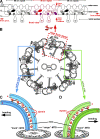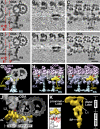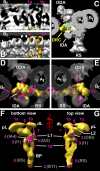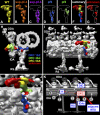The dynein regulatory complex is the nexin link and a major regulatory node in cilia and flagella
- PMID: 20008568
- PMCID: PMC2806320
- DOI: 10.1083/jcb.200908067
The dynein regulatory complex is the nexin link and a major regulatory node in cilia and flagella
Abstract
Cilia and flagella are highly conserved microtubule (MT)-based organelles with motile and sensory functions, and ciliary defects have been linked to several human diseases. The 9 + 2 structure of motile axonemes contains nine MT doublets interconnected by nexin links, which surround a central pair of singlet MTs. Motility is generated by the orchestrated activity of thousands of dynein motors, which drive interdoublet sliding. A key regulator of motor activity is the dynein regulatory complex (DRC), but detailed structural information is lacking. Using cryoelectron tomography of wild-type and mutant axonemes from Chlamydomonas reinhardtii, we visualized the DRC in situ at molecular resolution. We present the three-dimensional structure of the DRC, including a model for its subunit organization and intermolecular connections that establish the DRC as a major regulatory node. We further demonstrate that the DRC is the nexin link, which is thought to be critical for the generation of axonemal bending.
Figures





Similar articles
-
Detailed structural and biochemical characterization of the nexin-dynein regulatory complex.Mol Biol Cell. 2015 Jan 15;26(2):294-304. doi: 10.1091/mbc.E14-09-1367. Epub 2014 Nov 19. Mol Biol Cell. 2015. PMID: 25411337 Free PMC article.
-
Building blocks of the nexin-dynein regulatory complex in Chlamydomonas flagella.J Biol Chem. 2011 Aug 19;286(33):29175-29191. doi: 10.1074/jbc.M111.241760. Epub 2011 Jun 23. J Biol Chem. 2011. PMID: 21700706 Free PMC article.
-
In situ localization of N and C termini of subunits of the flagellar nexin-dynein regulatory complex (N-DRC) using SNAP tag and cryo-electron tomography.J Biol Chem. 2015 Feb 27;290(9):5341-53. doi: 10.1074/jbc.M114.626556. Epub 2015 Jan 6. J Biol Chem. 2015. PMID: 25564608 Free PMC article.
-
Ciliary Proteins: Filling the Gaps. Recent Advances in Deciphering the Protein Composition of Motile Ciliary Complexes.Cells. 2019 Jul 17;8(7):730. doi: 10.3390/cells8070730. Cells. 2019. PMID: 31319499 Free PMC article. Review.
-
Ciliary motility: the components and cytoplasmic preassembly mechanisms of the axonemal dyneins.Differentiation. 2012 Feb;83(2):S23-9. doi: 10.1016/j.diff.2011.11.009. Epub 2011 Dec 7. Differentiation. 2012. PMID: 22154137 Review.
Cited by
-
Motile cilia genetics and cell biology: big results from little mice.Cell Mol Life Sci. 2021 Feb;78(3):769-797. doi: 10.1007/s00018-020-03633-5. Epub 2020 Sep 11. Cell Mol Life Sci. 2021. PMID: 32915243 Free PMC article. Review.
-
Dual-allele heterozygous mutation of DNAH5 gene in a boy with primary ciliary dyskinesia: A case report.Medicine (Baltimore). 2023 Dec 29;102(52):e36271. doi: 10.1097/MD.0000000000036271. Medicine (Baltimore). 2023. PMID: 38206729 Free PMC article.
-
A computational model of dynein activation patterns that can explain nodal cilia rotation.Biophys J. 2015 Jul 7;109(1):35-48. doi: 10.1016/j.bpj.2015.05.027. Biophys J. 2015. PMID: 26153700 Free PMC article.
-
Axoneme Structure from Motile Cilia.Cold Spring Harb Perspect Biol. 2017 Jan 3;9(1):a028076. doi: 10.1101/cshperspect.a028076. Cold Spring Harb Perspect Biol. 2017. PMID: 27601632 Free PMC article. Review.
-
The nexin link and B-tubule glutamylation maintain the alignment of outer doublets in the ciliary axoneme.Cytoskeleton (Hoboken). 2016 Jun;73(7):331-40. doi: 10.1002/cm.21301. Epub 2016 Jun 13. Cytoskeleton (Hoboken). 2016. PMID: 27105591 Free PMC article.
References
-
- Bower R., VanderWaal K., O'Toole E., Fox L., Perrone C., Mueller J., Wirschell M., Kamiya R., Sale W.S., Porter M.E. 2009. IC138 defines a subdomain at the base of the I1 dynein that regulates microtubule sliding and flagellar motility. Mol. Biol. Cell. 20:3055–3063 10.1091/mbc.E09-04-0277 - DOI - PMC - PubMed
Publication types
MeSH terms
Substances
Grants and funding
LinkOut - more resources
Full Text Sources
Other Literature Sources

